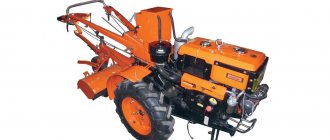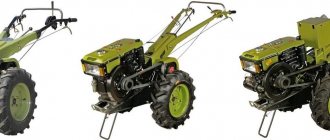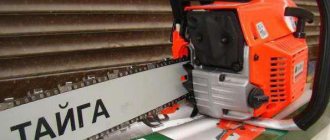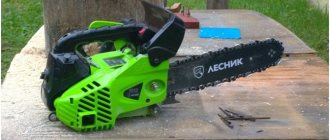Top models
Even 6-8 years ago, when choosing the most popular models of the Taiga brand, the 245 chainsaw would have been included in this list.
Today, this saw is morally outdated against the backdrop of foreign and domestic developments. Chainsaw Taiga 245
But among the many shortcomings, it is worth highlighting one main advantage of this device - reliability. Many summer residents still use Taiga 245, purchased back in the USSR. When choosing flagships among the new models, we can highlight: TBP-4000, TBP-6300 and BP-3650, BP-3840. Let's take a closer look at these models.
Taiga TBP-4000
Taiga TBP-4000 is one of the manufacturer’s most popular models. The power of this device is 4.0 kW, the length of the bar is 45 cm. Many owners use a 50 cm bar when working; the power of the saw is enough for this.
Chainsaw Taiga TBP-4000
Using a chainsaw, you can cut trees with a diameter of up to 70 cm. A full tank of fuel is enough for 30-45 minutes of continuous work. This saw is semi-professional, but is often used in logging operations. This saw is not suitable for garden work due to its heavy weight - 6.5 kg.
Taiga TBP-6300
This chainsaw is professional, its power is 6.3 kW. This saw is not suitable for sawing large amounts of wood, so it is rarely used in the forest.
Chainsaw Taiga TBP-6300
With prolonged use, it quickly heats up and loses power, but works well in sub-zero temperatures. The design has been improved with several additional features. A detailed review can be found here.
Taiga BP-3650 and 3850
Taiga BP-3650 and 3850 are small household chainsaws. BP-3650 is compact and easy to operate; it differs from the subsequent model in being slightly heavier (6.5 kg).
Taiga BP-3850 is a more powerful and lighter model, its weight is 5.5 kg. The saw is suitable for harvesting firewood of various densities and copes well with frozen wood. These models are available in two variations: with and without a set of additional saw parts.
Huter BS-45
Rating: 4.7
Why it is: Lightweight but powerful.
Thanks to its low weight of only 7 kg when fully operational (with chain and bar installed), this chainsaw is ideal for long-term work. In addition, anti-vibration design and sophisticated ergonomics reduce hand fatigue.
The chainsaw is equipped with a 45 cm bar, which is suitable for cutting even thick trees. The 0.325" chain pitch ensures a smooth, clean cut. And thanks to the 1800 Watt motor, the tool maintains optimal performance even when processing hardwood or knotted timber.
A fuel tank with a capacity of 0.55 liters is enough for 40-50 minutes of battery life. The chain brake mode increases safety during use.
Flaws
- The carburetor needs adjustment (the adjusting bolts are located on the body, and a screwdriver for them is included in the delivery kit);
- Incomprehensible instructions;
- The vibration dampers are equipped with plastic plugs;
The lineup
Initially, several versions of the chainsaw were created on the basis of the ZID, which differed:
- engine power;
- productivity;
- efficiency.
Heavier and more powerful ones were intended for industrial use. It is worth noting that the basis for all subsequent products in the line was 1 development: Taiga 214. Today the plant produces several improved models, lighter and easier to operate.
Chainsaw Taiga 214
Modern chainsaws are equipped with additional functions, such as soft start, emergency stop, continuous fuel supply, etc. Another difference is weight; chainsaws have become lighter due to the replacement of heavy metal parts with durable and lightweight plastic.
The Taiga chainsaw range includes:
- Taiga 214. First model. Intended for industrial and economic use.
- Taiga 245 (semi-professional saw for household use).
- Taiga BP-3650 (household model).
- Taiga BP-3850 (semi-professional tool).
Chainsaw Taiga BP-3850
Chainsaw Taiga TBP-4400 1
- Taiga TBP-4000.
- Taiga TBP-4400/1.
- Taiga TBP-4500.
- Taiga TBP-6300 (professional saw).
The first models 214 and 245 were developed back in the USSR and for that time they were powerful, reliable saws. Today these devices are morally outdated. It is unprofitable to use them in construction and industry. As for more modern models, they are recommended to be used for domestic needs. Some chainsaws, for example, TBP-4000, are not designed for cutting branches, as they are too heavy and cannot be used with outstretched arms.
Description of the chainsaw
You can find many statements online that Taiga chainsaws are manufactured in Russia. This is not true. Yes, Taiga is a Russian brand, but its assembly plants are located in China, where this model of chainsaw is produced. When assembling the product, Russian, Chinese and Japanese components are used, which helps improve the quality of the tools. The manufacturer establishes a warranty period of 24 months for its products. In this regard, many owners of Taiga chainsaws complain about the lack of certified service centers of this company.
Equipment
- Russian-language manual, product passport and warranty card;
- Unit housing with gasoline engine;
- Saw guide 450 mm. (2 pieces);
- Protective plastic case for transporting and storing the product;
- Saw chain 3/8″ (two pieces);
- Transparent plastic container for preparing fuel;
- Set of mounting keys;
- File for sharpening chain;
- Cardboard packaging.
Specifications
| Basic | |
| State | New |
| Manufacturer | Taiga |
| Nutrition | Gas engine |
| Tire length | 450.0(mm) |
| Chain pitch | 0.325″ |
| Number of revolutions | 9500.0(rpm) |
| Oil tank volume | 260.0(ml) |
| Weight | 7.0(kg) |
| Guarantee period | 12(months) |
| Characteristics of an internal combustion engine | |
| Engine capacity | 58.0(cc) |
| Engine power | 8.57(hp) |
| Number of cylinders | 1 |
| Fuel tank capacity | 550.0(ml) |
| Characteristics of the electric motor and battery | |
| Power consumption | 6300.0(W) |
| Additional functions | |
| Primer | Yes |
| Easy start | Yes |
| Chain brake | Yes |
| Vibration damping system | Yes |
| Adjusting the number of revolutions | No |
| Maintains constant speed under load | No |
| Starting current limitation | No |
| Keyless chain tension adjustment | No |
| Equipment | |
| Type of packaging | Paper box |
| Protection against chipping chips and splinters | No |
| Set of nozzles | No |
One of the advantages of the Taiga TBP-6300 chainsaw is the presence of a clear Russian-language manual, which the user receives in paper form when purchasing the tool. Online, the technical characteristics of this chainsaw and other important details can be found on the manufacturer’s website.
What carburetors are used on Chinese chainsaws
The most optimal carburetor designs for chainsaws were developed by the world's leading manufacturers - German Stihl, Japanese Walbro and others. These top developments are hard to beat. Therefore, most Chinese manufacturers copy the best models.
Some are nameless, from an unknown manufacturer and do not even have markings. They are simply offered for a specific chainsaw model. For example, a carburetor for a Stihl MS 361 chainsaw.
Others have brand names of well-known brands.
Still others have their own catchy names - in Russian transcription King Kong, Technopark, Rezet and others.
Care and maintenance
Before starting operation, you must read the instructions, safety precautions, check the technical condition of the unit and act in accordance with the manual.
Main malfunctions and ways to eliminate them:
- Presence of burrs on the working surface. Clean with a file or emery wheel.
- The tire is bent. Perform straightening.
- Reduced sawing efficiency. The teeth are sharpened, the lubrication channels are cleaned, and the chain tension is adjusted.
- The chain is clogged. Wash with gasoline.
- Stiff rotation or jamming of the sprocket. Wash the roller bearing with gasoline and lubricate it.
- The motor does not produce the required power. If the piston rings are defective, remove the cylinder, clean the rings and the piston from carbon deposits, wipe it, and lubricate it with auto scrap. If the crankcase rubber seals are worn out, replace them.
- There is a spark, but the saw does not start. Check for clogging of the fuel line.
Currently reading: Chainsaw forester device
The engine does not start for the following reasons:
- Lack of fuel in the tank.
- Spark plug faulty.
- Oily electrodes or violation of gaps.
- No spark.
- Fuel intake clogged.
- Rich oil saturation.
The process is performed by 3 screws, which are located on the deflector and fan cover:
- screw “X” is responsible for adjusting XX;
- screw “P” - for low speed;
- the latter - for power and rotation speed.
When making the first adjustment, which occurs in a muffled state, the low and high speed screw is turned out by 1 and ¼. Then start the saw and warm it up.
The final adjustment is carried out with the engine running and warm, and the ratio of the composition and quantity of the fuel mixture is changed with screws.
Taiga chainsaws require regular preventative and maintenance. Its timely implementation allows you to extend the working life of the tool with proper performance.
Such activities include the following:
- Before each start-up, check the serviceability of the unit, the tightness of the fuel and oil systems, the reliability of fixation of the carburetor with the cylinder, as well as the tightening of fasteners and the tension of the operating chain.
- Cleaning the ventilation grille, air filter and carburetor deflector.
- Periodically, the filter element must be washed in gasoline or kerosene.
- At the end of the work, open and clogged components should be cleaned of chips and dirt.
- The working chain is washed in an oil-gasoline mixture, having previously cleaned it.
- Small pressed wood must be removed from the tire grooves and sprocket teeth.
- You should also clean the oil channel by unscrewing the clamping screw located at the bottom of the crankcase.
It is important Which Forte walk-behind tractor to choose
Unpacking, installation and preparation for use
- When purchasing a chainsaw, ask the seller to start the engine to make sure it is in good working order;
- Carry out a thorough visual inspection of the instrument to ensure there is no visible damage. If defects are detected, demand that the detected problems be corrected, or the Taiga saw replaced with a similar one;
- Read the manual carefully, study the technical specifications and safety rules when working with chain saws;
- Check the reliability of fastening of all components and parts, tighten the mounting bolts and nuts;
- Remove the protective casing covering the drive sprocket;
- Place the bar on the splines, insert the chain into the grooves of the bar and put it on the drive sprocket;
Important: make sure that when installing the chain, the cutting edges of the teeth point in the direction of rotation of the drive sprocket.
Chainsaw Taiga
- Secure the protective cover and saw set with fastening nuts, adjust the chain tension;
Important: with the correct tension, not one of the links sags, and the chain itself rotates on the bar under a light hand effort, without making any extraneous sounds.
- Tighten the fastening nuts until they stop, check the chain tension again;
- Fill the tank with fuel and refuel the automatic lubrication system of the saw set.
Frequent malfunctions
One of the first Russian models of chainsaws that had a modern appearance and the ability to use the tool regardless of location in space was the Taiga 214 saw.
Let's look at the main malfunctions of Taiga chainsaws, which you can independently diagnose and fix:
- There is no spark at the spark plug contacts. Reasons: a faulty spark plug or ignition module, a broken high-voltage wire or a loose cap, the gap between the coil and the flywheel is not adjusted.
- There is a spark, but the saw does not start. Reasons: clogged fuel line or carburetor, depressurization of the crankcase, oiling of the fuel pump membrane or the main chamber of the carburetor.
- The saw starts and stalls. Reasons: strong air leaks into the crankcase, disturbances in the fuel supply system.
- The saw runs at idle, but stalls when you press the gas. Reasons: clogged main chamber injector valve, clogged fuel line, air leak into the carburetor.
- The chain rotates constantly. Reasons: clutch spring burst, increased idle speed as a result of incorrect carburetor adjustment.
- The saw spontaneously increases speed when changing its position in space. Causes: rear shock absorber is torn, carburetor is incorrectly adjusted (not enough fuel).
| Symptoms | Possible reason | Remedy |
| Chainsaw engine does not start | There is no fuel mixture in the tank. The ignition is not turned on. The spark plug is faulty or clogged. | Refuel the chainsaw Turn on the ignition Replace or repair the spark plug |
| The engine runs unevenly, after pressing the accelerator trigger it picks up speed with a delay | Carburetor adjustments are out of order | Adjust the carburetor |
| The engine starts but stalls almost immediately | Carburetor unbalanced | Restore the correct host settings |
| Work productivity has dropped sharply, the smell of burnt wood can be heard | The chain is not put on correctly The saw chain is dull | Rearrange the chain and sharpen it |
| Engine power has dropped | The muffler is faulty or dirty | Disassemble the unit, clean it of burning and accumulated debris. If necessary, replace the muffler. |
| There is a lot of smoke when the engine is running. | The dosage of oil was exceeded when preparing the fuel mixture. Instead of motor oil, chain oil was used | Drain the fuel mixture and replace it with fresh one. |
| Oil is leaking | The tightness of the oil line is broken. The oil pump is faulty. | Find the leak and restore the seal Replace the assembly |
User manual
The operating instructions include the following points:
- Recommendations for working with the device.
- Recommendations for using the fuel mixture. To refuel a chainsaw, you need to prepare a special mixture, strictly adhering to the proportions. For fuel, you need to mix AI-92 gasoline with some oil. If the correct and necessary ratios of components are not observed, there is a risk of carbon deposits appearing on the cylinder, which will negatively affect the service of the gasoline saw tool.
- Safety precautions.
- Recommendations for maintenance.
First launch and run-in
When the fuel mixture is ready, the chain tension is assembled. Fuel and oil tanks are filled with appropriate fluids. The chain saw starts, the operator adjusts the idle speed and controls the supply of lubrication to the chain.
Proper preparation of the fuel mixture
For break-in it is necessary: mix the fuel mixture in a ratio of 50/2, use reduced loads on the engine (no more than 50%), run-in for a period equal to the use of 4 full tanks of fuel.
Maintenance
Maintenance includes:
- timely replacement of oil and fuel mixture (every 3-4 weeks);
- carrying out inspections for defects before and after work;
- cleaning of structural parts;
- replacement of parts.
It is recommended to choose original parts or similar ones from other manufacturers as replacement elements. As for oil, mixtures for two-stroke engines are excellent.
Basic malfunctions and ways to eliminate them
| Breaking | Cause | Solution |
| The saw does not start or gradually stalls. | Blockages in the fuel system or carburetor. Oil getting into the fuel membrane. The spark plug or ignition module is faulty. | Inspect and clean structural elements. If necessary, replace failed elements, a spark plug or a module. Fill the engine with the fuel mixture and run it at idle speed. Advice! A working spark plug will have a sandy color until it is cleaned. |
| The fuel filter is not working. | The fuel filter becomes dirty. | Replace the fuel filter. It is recommended to carry out the replacement procedure every 3 months. |
| The chain rotates without stopping. | Incorrect carburetor adjustment, clutch spring burst. | Inspect the engine and carburetor, ignition system. Replace the clutch spring and adjust the carburetor. To check, run it at idle speed. |
Depending on the model, breakdowns may vary. Due to the lack of additional systems, older models fail less often, but require frequent carburetor adjustments. It is worth noting that all models have the ability to sharpen the saw chain, which reduces the frequency of its replacement.
Frequent malfunctions
Let's look at the main malfunctions of Taiga chainsaws, which you can independently diagnose and fix:
- There is no spark at the spark plug contacts. Reasons: a faulty spark plug or ignition module, a broken high-voltage wire or a loose cap, the gap between the coil and the flywheel is not adjusted.
- There is a spark, but the saw does not start. Reasons: clogged fuel line or carburetor, depressurization of the crankcase, oiling of the fuel pump membrane or the main chamber of the carburetor.
- The saw starts and stalls. Reasons: strong air leaks into the crankcase, disturbances in the fuel supply system.
- The saw runs at idle, but stalls when you press the gas. Reasons: clogged main chamber injector valve, clogged fuel line, air leak into the carburetor.
- The chain rotates constantly. Reasons: clutch spring burst, increased idle speed as a result of incorrect carburetor adjustment.
- The saw spontaneously increases speed when changing its position in space. Causes: rear shock absorber is torn, carburetor is incorrectly adjusted (not enough fuel).
These are the main malfunctions that owners of Taiga chainsaws have to face; in order to find out how to eliminate these and other malfunctions, we recommend reading the general article on the repair and adjustment of chainsaws.
We present to your attention several reviews from real owners of Taiga chainsaws.
Two years ago, I bought a Taiga TBP - 4000 chainsaw. The seller recommended it to me. According to him, this is a high-quality Russian-made chainsaw. Later, I found out that this was not so, I was simply deceived. There are no complaints about the work of the saw, but the quality of the body parts did not please me at all. The plastic is cheap, and over time it began to warp, especially the side cover that presses the tire. I don’t work with the saw a lot, it cuts normally, there’s enough power. Almost as soon as I started working, I noticed that the tip of the tire was getting very hot. I tried to lubricate it, but it didn't work. As a result, the sprocket on the tire jammed and the headset had to be replaced. So far, there have been no more problems with the saw, but it seems to me that this will not last long. I don’t recommend Taiga TBP 4000 to anyone; it’s better to take something more reliable, albeit a little more expensive.
Andrey. 44 years old. Smolensk
Two years ago my old chainsaw broke. I decided not to repair it and buy a new one. Before buying, I consulted with a friend, he said that he uses a Taiga BP 3850 chainsaw and likes it. I bought it and regretted it. In two years, I changed the saw bar, the drive sprocket, the starter, and repaired the carburetor. The chainsaw is quite powerful and cuts well, but its quality is very low. It seems that the manufacturer saved on everything. The plastic is fragile and breaks in the cold. Last year, at a temperature of -25, I needed to cut down an old tree, I tried to start the chainsaw, but the choke lever simply broke off. Of course, I understand that this is a budget chainsaw, but not to the same extent. Was it really impossible to make a wire choke lever, like on other Chinese chainsaws? Such little things really spoil the impression of the saw, and I no longer want to recommend it to anyone.
Stanislav. 52 years old. Ufa.
Characteristics of chainsaw brand 245 from
When considering Taiga chainsaws, you should pay attention to the 245 model, which is semi-professional equipment with a large weight - 8.95 kg. The tire is 40 cm long, which is quite enough for sawing 30 cm logs
The device is powered by a two-stroke engine with a power of 2.6 kW, or 3.5 liters. With.
You may also be interested in the chain pitch, which for this equipment is 9.3 mm. You can fill the fuel tank with gasoline, the volume of which will be from 0.7 to 0.8 liters. Such Taiga chainsaws can easily cope with preparing firewood, trimming branches, and felling small trees.
Comparative parameters of the closest competitors
The Taiga chainsaw, the characteristics of which, depending on the modification, allows it to be used for domestic needs and in production, has many competitors. Let's look at the main representatives and their brief parameters.
The German model “Shtil MS-341” is a semi-professional saw, has a power of 2.6 kW, and weighs 4.5 kg. The tire has a length of three hundred and fifty millimeters. There are also many professional models from this manufacturer. Their power can reach 65 kilowatts, and the tire size is 75 centimeters.
“Husqvarna-142” - this unit from a well-known manufacturer belongs to the semi-professional category. With dimensions of 415*310*260 mm, the chainsaw has an engine capacity of 40 cubic centimeters and a power of about two and a half horsepower. It is practical and reliable.
ECHO is a gasoline saw from a young but actively developing Japanese company that has taken its rightful place in the world market. For example, the CS-305WS 14 model, with a power of two horsepower, easily fells small trees, is easy to use, and economical.
Description
Taiga chainsaws are high-quality domestic equipment that can be used both on an industrial scale and at home. Most Taiga models are made on the basis of metal parts, which is why they weigh more than their analogues.
Most owners prefer Taiga chainsaws, as they are easy to operate and do not require additional repair costs. You can replace all components or adjust the carburetor yourself without contacting a service center.
Taiga chainsaws are classified:
- professional;
- semi-professional.
The second type is intended for use in industry and suburban areas.
The classification of products in the model range depends on:
- technical characteristics;
- product weight;
- power;
- quality and component manufacturer.
Some products in the Taiga line of chainsaws are equipped with Walbro carburetors. This is an American company that specializes in the production of carburetors for various equipment, including chainsaws.
Walbro has many subsidiaries in different countries: Mexico, Japan, China. When creating Taiga chainsaws, the Soviet Union entered into an agreement for the supply of carburetors from Japan. Today, Walbro carburetors are supplied to Taiga from China, Japan and the USA.
Walbro is the most trusted and experienced manufacturer of two-stroke carburetors in the world.
Manufacturer of chainsaws: USSR, Russia.
Features of the Chinese chainsaw carburetor
Their design and parameters differ depending on the power and model of chainsaw they are intended for. All of them are almost identical to the original carburetors in design, but not always in quality. Today, all Chinese products cannot be considered 100% rubbish. In turn, according to their quality, they can be divided into three groups:
- Poor quality. Unsuitable alloys are used which oxidize, crumble and break. There is no accuracy of fit, the calibrated holes do not correspond to the required values, which leads to excessive consumption or lack of fuel in the combustion chamber. Critical parts quickly fail. Plastic parts quickly become rough or, conversely, become softened by gasoline and stop working. The axles and wire rods are bent, the threads of the fasteners are torn off. Such products are the cheapest. They are made in semi-handicraft industries using adapted equipment. As a rule, they do not have a name or marking.
- Carburetors are of average quality. These are factory assembled products. They do not skimp on alloys; they have established continuous production with quality control. These are fully functional carburetors that can have a service life even longer than that of the entire chainsaw.
- High quality carburetors. First of all, these are products from global manufacturers whose facilities are located in China. Geographically, they can be considered Chinese, but they are made using the technologies of the company that owns the brand and values its reputation. For example, Japanese Walbro carburetors are produced in China.
Chainsaw Taiga 245. DIY repairs
Probably many people now have among their tools such a tool as a chainsaw. This is undoubtedly a very necessary tool in the household, but like any tool it tends to break. One of the most popular brands of chainsaw is Taiga 245
Several main characteristics of this chainsaw:
— Engine – single-cylinder, two-stroke, petrol; — Power 2.6 kW; — Fuel consumption 600 g KW per hour; — Overall dimensions 280*900*300 mm; — Weight – 8.95 kg. A photo of this chainsaw can be seen below
Chainsaw Taiga 245 do-it-yourself repair - major breakdowns:
1) Engine malfunctions. very often breakdowns occur in the engine part and most often this is when the engine does not start, starts but does not work normally and at the same time stalls, runs unstably, does not gain the necessary power.
Almost all of these problems arise from improper operation of the ignition system.
Important The design of the MAZ brake system and how to troubleshoot it
Therefore, if any of these breakdowns occur, then you must first begin repairs with spark plugs. Therefore, you just need to roll up the candle and inspect it thoroughly.
The wire will need to be disconnected and the spark plug removed using the correct wrench. If the spark plug is dry, then there is a problem with the fuel mixture not entering the cylinder.
If the spark plug is very heavily stained with the fuel mixture, this means that there is a large excess of it. The candle is wiped, dried, then put back in place and the start is repeated again.
2) Supply of a mixture of fuel. If it has been determined that fuel does not enter the cylinder, this may be due to the following reasons:
— in this case, it will be necessary to create a vacuum in the tank, which will prevent the possibility of fuel leaking out — A high level of contamination of the fuel filter installed in the tank — Insufficient supply or no possibility of fuel entering the cylinder at all. In order to eliminate the first two reasons, you just need to disconnect the fuel hose from the carburetor and see whether fuel is leaking from it or not.
If this fuel does not flow, then it is the cause of the malfunction. The breather will need to be cleaned with a needle.
The fuel tank will need to be removed through the filler hole using the empty fuel tank using a wire hook along with a suction hose. It is recommended to change this fuel filter every 3 months.
3) Muffler. Quite often, the cause of the malfunction is that the muffler becomes clogged with combustion products from the spark arrester and thus prevents high-quality exhaust.
In order to repair, you need to remove the muffler, disassemble it and clean it completely using detergents. If the muffler is not dismountable, then it will also need to be dried with a hairdryer. When the muffler is removed, you will need to plug the exhaust hole with a rag. The muffler can also become clogged if fuel with excess oil is used.
4) Cylinder - piston group. The malfunctions associated with this group are very serious. This may be wear on the piston rings or bearing wear. All these malfunctions lead to a drop in pressure in the cylinder. To repair, you need to remove the muffler and look at the condition of the cylinder-piston group. You also need to measure the compression level in the engine.
All this is done using a compression gauge, which is installed in the spark plug hole. The crankshaft is rotated using an electric motor.
The pressure gauge readings should not be lower than 8 - 9 atm. If the indicator drops to 5 atm, then the engine most likely will no longer work.
5) Chain brake. Incorrect operation of the brake chain is caused by contamination of the brake band with lubricants and sawdust. In this case, you need to either clean the under-axle space or replace the brake band.
Valka
Felling is the art of cutting down a standing tree. Examine a tree and you may be able to immediately see in which direction it is most likely to fall. If possible, focus on natural, natural cues. Sparse or, on the contrary, dense branches on any one side of the trunk will probably affect the direction of the fall more than the cuts you make.
However, many circumstances can disrupt your plans. Thus, a falling tree can get stuck in the crowns of neighboring trees. This situation is extremely dangerous. If you are not an ace, then find one and ask for help, not letting anyone get close until the tree falls
Be sure to pay attention to the location of power lines, the proximity of your home, neighboring houses and other buildings. If you have any doubts about the exact and safe direction of the fall, do not try to fell the tree yourself - it is better to invite a professional. Remember that the danger zone is a circle with a radius equal to twice the height of the tree
Remember that the danger zone is a circle with a radius equal to twice the height of the tree.
Once you are completely confident in your felling plan, clear an area to work around the tree (see Photo 2), then mark two different directions for a quick escape. When the tree starts to fall, you must run away from it in one of the intended directions. If things don't go according to plan, you'll have to retreat very, very quickly. Even experienced woodcutters cannot always accurately
predict where a tree to be felled will land. Directions for quick escape should lie at an angle of 45 degrees from the direction of fall. Never plan a route opposite to the direction the tree is falling, since either the tree may fall backwards or, when falling, lift up the entire root system along with layers of earth right under your feet.
the trunk remains connected to the stump, which keeps it from rolling on the ground and, as a result, makes pruning and bucking easier and safer.
The felling method we describe is called the open hem method. It has two advantages. Firstly, the remaining part of the trunk, called the “undercut” and located behind the undercut, holds the trunk until it falls, since the undercut will not close until the trunk is on the ground. Secondly, however, even the best cutting technology will not save you from surprises when felling hollow trees, as well as from gusts of strong wind. Do not cut down trees in strong winds - wait for a better day.
An assistant with a meter stick should stand at a distance of 1.5-2 m from the lumberjack. He must keep an eye out for possible hazards, allowing the logger to fully concentrate on the job.
If the assistant notices impending danger, he attracts the lumberjack's attention with a light blow of a stick on the shoulder. The lumberjack must immediately drop the chainsaw and retreat with an assistant to a safe place
Performance overview
The functionality of this model determines its suitability for the effective mechanization of work on dumping dead wood, sawing fuel wood and preparing construction wood for installation. The high performance of this model is achieved due to the traction parameters of a carburetor two-stroke engine with a volume of 65 cm3 and a power of 3.5 hp.
The layout of the tool takes advantage of the gearless drive of a 16-inch saw guide bar, a balancing mechanism that meets modern requirements for starting systems, fuel supply, cooling and lubrication of the saw set.
The advantages of the 214 series chainsaw:
- long battery life and economical fuel consumption;
- unpretentiousness to the used fuels and lubricants;
- ability to work with wood with a diameter of up to 300 mm;
- stability of traction characteristics in operating modes.
The model, universal in many respects, is aimed at mastering large volumes of sawing work of varying complexity. The capabilities of the tool are effectively realized by the power of a 3-horsepower, low-speed power unit with a cylinder volume of 75 cm3.
The list of advantages of the 245 series chainsaw:
- lighter weight compared to the previous model (within 4.8 kg);
- manual cord starter with quick start device;
- simplified carburetor adjustment without a float type, with a built-in pressure regulator and booster pump;
- possibility of felling and bucking wood with a diameter of 3500 mm;
- time-saving disassembly of the saw set for sharpening or replacing the saw chain.
Taiga 3850
A household-grade chainsaw with a powerful drive and modern technical equipment is capable of mastering a wide range of chores related to sawing any wood, including dense and frozen wood with a diameter of up to 500 mm.
The model is equipped with a 4.3-horsepower engine with an easy start device and a booster pump, a 20-inch headset with an automatic chain lubrication system.
Work comfort is ensured by:
- full-fledged vibration damper;
- modern case design;
- excellent balance and convenient handle shape for working from different positions.
Advantages and disadvantages of the Carver 246 chainsaw
Satisfied owners in their reviews note the following advantages in the technical characteristics of the saw:
- quick and trouble-free engine starting thanks to the QuickStart system;
- the chainsaw is suitable for use in different climatic and weather conditions due to the primer and high quality body material;
- comfortable handle with vibration damping system for more comfortable and enjoyable work;
- metal crankcase Carver RSG 246 01.004.00034 guarantees long and trouble-free service life;
- an improved engine that guarantees a more powerful and productive work process with minimal fuel consumption;
- The chrome-plated cylinder will now last even longer.
"Taiga-214": a brief overview
The Taiga chainsaw, reviews of which are mostly positive, has a cantilever-type saw part, which includes a bar, chain and drive sprocket. Lubrication during operation occurs continuously in automatic mode, provided by a plunger pump. The supply unit and oil reservoir are located on the motor body. The pump is driven by a worm gear; no additional adjustment of the tool is required.
In warm weather, the same oil is used to lubricate the working part and the fuel mixture. In the cold season, it is diluted with gasoline in a ratio of one to three. The sleeve on the tire is connected to the oil tank and the guide groove through specially provided holes. Oil is supplied through the gearbox input shaft, which drives the plunger. Further, due to the rotational movements of the element, the lubricant enters the working grooves and then to the chain. The technical characteristics of model 214 are almost identical to the Taiga-245 modification.
What do the owners say?
The Taiga chainsaw, reviews of which can be found on special forums and trading resources, is in great demand among the population. Particularly popular are the latest models, which combine high performance, durability and low weight. There are no particular complaints about the functionality of this tool. Owners make certain complaints about the carburetor, which often gets clogged and takes a lot of time to clean. In some models, users are not satisfied with the air filters, which they advise immediately replacing with a more practical option.
About this element we can say that it is nylon or made of fabric (felt). The first option is easy to clean, suitable for reusable use, however, it is damaged if large sawdust gets in. The felt filter is more resistant to mechanical stress, but is quite difficult to clean.
Conclusion
Chainsaw Taiga 245 is perfect for home use. It still lacks reliability for working in the forest and is hampered by excess weight. The chainsaw is easy to repair; most faults can be fixed with your own hands. Spare parts are available and not expensive. The affordable price covers all the shortcomings and makes it an excellent mid-range saw in its class.
The sawing apparatus of the Taiga-214 chainsaw consists of a shortened solid cantilever-type bar, a PTSU-10.26 saw chain, driving and driven sprockets. The tire is attached to the crankcase attachment with two studs. The tension of the saw chain is adjusted using a screw located at the end of the platform under the bar; When screwing it in, the saw chain is tensioned.
Chainsaw Taiga, instruction manual. The sawing apparatus of the Taiga-214 chainsaw consists of a shortened solid cantilever-type bar, a PTSU-10.26 saw chain, driving and driven sprockets. The tire is attached to the crankcase attachment with two studs. The tension of the saw chain is adjusted using a screw located at the end of the platform under the bar; When screwing it in, the saw chain is tensioned. The Taiga chainsaw is one of the best saws on our market. The Taiga 245 chainsaw model is especially popular.
Manufacturer country
This article has nothing to do with Taiga ZiD chainsaws, since there is no information on the official ZiD website that the plant is currently producing chainsaws. If you are interested in information on Soviet-made Taiga chainsaws, then read our review articles: Taiga 214, Taiga 245.
Then where are the saws produced that are sold today under the name Taiga? We can definitely say that they are made in China, but who imports them into our country is unknown. These chainsaws do not have an official website, service centers, in general, there is no reliable information about who should be responsible for quality.
Their Chinese origin can be determined by their appearance, body and engine details. Many people probably know the “Gypsy” chainsaw, but here are the Taiga saws, one of its varieties, only with a different color.











